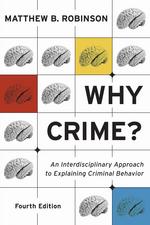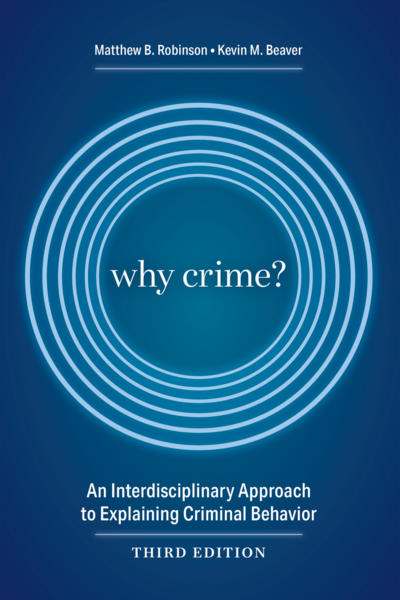This title has been replaced by a newer edition:
Why Crime?: An Interdisciplinary Approach to Explaining Criminal Behavior, Fourth Edition
2025, 520 pp, paper, ISBN 978-1-5310-2856-5
$80.00
Why Crime?
An Interdisciplinary Approach to Explaining Criminal Behavior
Third Edition
by Matthew B. Robinson, Kevin M. Beaver
2020
Tags: Criminal Behavior and Theory
538 pp $70.00
ISBN 978-1-5310-1640-1
eISBN 978-1-5310-1641-8
Why Crime? summarizes the latest empirical evidence with regard to the risk factors that produce antisocial and criminal behavior. The authors then meaningfully integrate risk factors identified by more than a dozen academic disciplines that increase the odds of antisocial behavior and criminality. The result is a new interdisciplinary theory that helps break down traditional barriers and overcomes the "disciplinary myopia" that plagues criminological theory. Unlike the typical criminological theory text, Why Crime? actually advances the state of criminological theory as well as the field of criminology. The third edition also features findings from the first ever test of the Integrated Systems Theory.
There is a set of PowerPoint slides available upon adoption. Click here to view a sample presentation. If you are a professor using this book for a class, please contact Beth Hall at bhall@cap-press.com to request your slides.
Praise for earlier editions:
Editorial Reviews
Whether your interest is macro or micro, society or genes, Why Crime? is a tour-de-force through the criminological literature. Professors Robinson and Beaver have brilliantly explicated the interdisciplinary research on crime in a concise, fun-to-read text."—
What Robinson and Beaver have achieved is striking. Not only do they integrate a sound understanding of biology's role in criminal conduct into a broader biosocial paradigm, but they do so in a way readers will find accessible. This book will certainly draw the ire of some, but for serious students of crime it will force a reconsideration of cherished beliefs. For this reason alone, Why Crime? makes a valuable contribution to the study of crime."—
[T]he most ambitious, comprehensive interdisciplinary attempt so far to move integration of criminological theory to new heights."—
[E]ngaging, extremely well written, [a] major contribution to criminology… a tour de force for the criminologist who wants to learn something about the biosocial perspective."—
[The] integrated systems theory ... serves as an example of some of the best work now being done in the area of theory integration." Dr. Frank Schmalleger, University of North Carolina—
Comp Copy If you are a professor teaching in this field you may request a complimentary copy.



